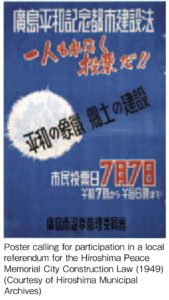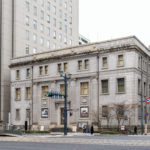Q3 What laws and frameworks supported Hiroshima’s reconstruction?
 The Japanese National Government launched its reconstruction projects by establishing the War Damage Reconstruction Agency in November 1945. On December 30 of that year, the Cabinet adopted “the Basic Policy for the Reconstruction of War-damaged Areas,” targeting on 115 cities that had suffered particularly severe damage and starting reconstruction projects centered on land readjustments.
The Japanese National Government launched its reconstruction projects by establishing the War Damage Reconstruction Agency in November 1945. On December 30 of that year, the Cabinet adopted “the Basic Policy for the Reconstruction of War-damaged Areas,” targeting on 115 cities that had suffered particularly severe damage and starting reconstruction projects centered on land readjustments.
The City Planning Division of the Hiroshima Prefectural Government took a leading role in the reconstruction of Hiroshima City. By November 1946, the division formulated the Hiroshima Reconstruction City Planning that included projects for roads, parks and green areas, and land readjustment based on feedback from Hiroshima City government and local residents. Reconstruction projects for roads and parks and green areas were implemented under the framework of the previously developed City Planning Act. Regarding land readjustments, ad hoc city planning act went into effect in September 1946, and land readjustment projects were implemented under its framework.
Meanwhile, a variety of ideas (e.g. selling the war-devastated lands, building a horse racing track, and holding lotteries) were proposed to raise funds for reconstruction in addition to the two lotteries that were held: the Hiroshima Prefecture School Reconstruction Lottery (1948) and the Hiroshima Prefecture Public Infrastructure Reconstruction Lottery (1949). However, neither of these resolved the problem, nor did giving the former military land, which spread across 585 hectares, to the city free of charge, something that the city had the highest hopes for.
Shinzo Hamai, was elected as a mayor of Hiroshima in 1947 and started petitioning the GHQ, the National Government and the Diet in November  1948. He intended to acquire support from the National Government by getting special legislation approved. The mayor persuaded the authorities of the significance of using national funds for Hiroshima’s reconstruction as a peace memorial city, and intended to formulate the Hiroshima Peace Memorial City Construction Law. Tadashi Teramitsu, Director General of the Proceedings Department of the House of Councillors and originally from Hiroshima drafted a bill that passed both houses as legislation initiated by House members in May 1949 after obtaining the approval of the GHQ. Both houses approved the bill unanimously.
1948. He intended to acquire support from the National Government by getting special legislation approved. The mayor persuaded the authorities of the significance of using national funds for Hiroshima’s reconstruction as a peace memorial city, and intended to formulate the Hiroshima Peace Memorial City Construction Law. Tadashi Teramitsu, Director General of the Proceedings Department of the House of Councillors and originally from Hiroshima drafted a bill that passed both houses as legislation initiated by House members in May 1949 after obtaining the approval of the GHQ. Both houses approved the bill unanimously.
The Hiroshima Peace Memorial City Construction Law is made up of seven articles. Article 1 states “It shall be the objective of the present law to provide for the reconstruction of the city of Hiroshima, as a peace memorial city, to symbolize the human ideal of the sincere pursuit of a genuine and lasting peace,” and Article 4 clearly states that ordinary assets may be transferred to local public entities as deemed necessary by the National Government. The law paved the way for reconstruction under the generous support of the National Government.
Inquiries about this page
Hiroshima Prefectural Office
Street address:10-52, Motomachi, Naka-ku, Hiroshima-shi, Hiroshima-ken, 730-8511
Tel:+81-(0)82-228-2111








